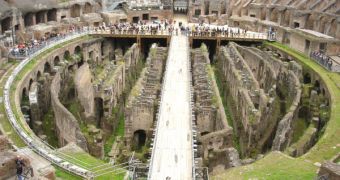At an ancient port site, located just outside of the Italian capital city of Rome, archaeologists from the United Kingdom have discovered a new amphitheater, which they argue could have served ceremonial purposes. Roman emperors may have used the structure as a welcoming site, for foreign dignitaries traveling to the Empire. Leaders such as the emperors Trajan and Hadrian may have been at home in this amphitheater, the experts believe. Early studies indicate that more than 2,000 people could easily fit inside the structure, the BBC News reports.
Other possible uses for the impressive site may have included gladiator fights, as well as animal baiting, the University of Southampton (USouthampton) team reveals. It was discovered inside a gigantic, imperial-style palace, located near the ancient harbor of Portus (Latin for port), some 20 miles (32 kilometers) away from Rome. The investigation team, which also included experts from the Cambridge University, spent more than two years at the site, and says that Portus deserves a lot more recognition and international attention than it's currently getting.
Although the initial port was obviously on the shores of the Mediterranean Sea, it is now located about two miles inland, next to the Fiumicino Airport. It was two times larger than the modern harbor serving Southampton, and was used to bring slaves, merchandise, food and construction materials to the Empire, the archaeologists believe. The newly found amphitheater is oval-shaped, and similar in size to the Pantheon in Rome. It was unearthed in the eastern wing of the impressive palace.
“Its design, using luxurious materials and substantial colonnades, suggests it was used by a high status official, possibly even the emperor himself, and the activities that took place there were strictly private. It could have been games or gladiatorial combat, wild beast baiting or the staging of mock sea battles but we really do not know. What we do know is it's unusual to find this type of building with elements of imperial architecture so close to a harbor,” Portus Project Director, Professor Simon Keay says.
The find is “going to generate a lot of rethinking about how ports were used and that will change the way we think about Rome's relationship with the Mediterranean. The site has been known about since the 16th century but it has never been given the importance it deserves. It has been grossly understudied,” the expert adds. He believes that the find is so important, that it should be rated alongside “such wonders as Stonehenge and Angkor Wat in Cambodia.”

 14 DAY TRIAL //
14 DAY TRIAL //